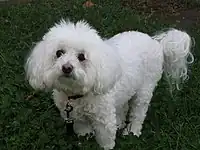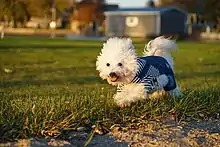| Bichon Frisé | |||||||||||||||||||||||||
|---|---|---|---|---|---|---|---|---|---|---|---|---|---|---|---|---|---|---|---|---|---|---|---|---|---|
 | |||||||||||||||||||||||||
| Other names |
| ||||||||||||||||||||||||
| Origin |
| ||||||||||||||||||||||||
| |||||||||||||||||||||||||
| |||||||||||||||||||||||||
| Dog (domestic dog) | |||||||||||||||||||||||||
A Bichon Frisé (/ˈbiːʃɒn ˈfriːz/ or /ˈbiːʃɒn frɪˈzeɪ/; from French: bichon à poil frisé, French pronunciation: [biʃɔ̃ fʁize], meaning 'curly haired dog') is a small breed of dog of the bichon type.
Etymology

The French word bichon comes from Middle French bichon ('small dog'), a diminutive of Old French biche ('female dog', cognate with English bitch), from Old English bicce, and related to other Germanic words with the same meaning, including Old Norse bikkja, and German Betze.[1][2] Some speculate the origin of bichon to be the result of the apheresis, or shortening, of the word barbichon ('small poodle'), a derivative of barbiche ('shaggy dog'); however, this is likely impossible, since the word bichon (attested 1588) is older than barbichon (attested 1694).[3][4] While the English name for the breed, Bichon Frise, is derived from the French bichon à poil frisé meaning 'curly haired small dog'.[5]
History

The Bichon Frisé is often depicted as a French dog. Although the Bichon breed type are originally Spanish, used as sailing dogs, also as herding dogs sometimes, the French developed them into a gentle lap-dog variety. The Bichon type arose from the water dogs, and is descended from the poodle-type dogs and either the Barbet or one of the water spaniel class of breeds.[7]
Because of their merry disposition, the ancestral Bichons travelled much and were often used as barter by Italian sailors as they moved from continent to continent.[8] The dogs found early success in Spain and it is generally believed that Spanish seamen introduced the early breed to Tenerife in the Canary Islands. Their association with European nobility began in the 13th century, entering the royal courts of Spain, Italy and France.[9] In the 14th century, Italian sailors rediscovered the dogs on their voyages and are credited with returning them to continental Europe.[10]
The Tenerife, often simply called the Bichon, had success in France during the Renaissance under Francis I (1515–1547), but its popularity increased in the court of Henry III (1574–1589), when it had become popular amongst French nobility as both a court companion and lap dog.[11]
On 5 March 1933, the official standard of the breed was adopted by the Société Centrale Canine, the national kennel club for France.[12] On 18 October 1934, the Bichon Frisé was admitted to the stud book of the Société Centrale Canine.
The Bichon was brought to the United States in 1955.[13]
The Bichon Frisé became eligible to enter the AKC's Miscellaneous Class on 1 September 1971. In October 1972, the breed was admitted to registration in the American Kennel Club Stud Book. On 4 April 1973, the breed became eligible to show in the Non-Sporting Group at AKC dog shows. In 2001, a Bichon Frisé named J.R. won best-in-show at the Westminster Kennel Club Dog Show. In the United States, the Bichon Frisé was ranked the 40th most popular breed in 2013 according to the American Kennel Club.[14]
The Bichon was introduced into Australia in the 1970s and since its introduction has proved successful as both a show and companion dog.[15] In 1973, two American breeders emigrated to the United Kingdom with two Bichons, who produced a litter of five pups, introducing the breed into the country.[16]
Description
Appearance
The Bichon Frisé is a small dog that weighs approximately 6–11 kilograms (10–20 pounds) and stands 23–30 centimetres (9–12 inches) at the withers, but slightly larger dogs are not uncommon. The skull is slightly rounded and the muzzle is not pointy. The tail is groomed to be long and curly and is carried over the back. It has a black nose and dark round eyes; its white hair consists of a curly, dense coat with little shedding (much like a poodle in this respect), although many of the breeds do tend to have less curly hair than others. A small amount of buff, cream, or apricot colour may be seen around its ears, snout, paws or body, but normally these colours do not exceed 10% of its body. FCI/AKC Standard coat colour is pure white; other colours such as apricot or grey and brown are not recognised. A white coat is preferred in the show ring. The head and legs are proportionate in size to the body, and the ears and tail are natural (not docked or cropped).[17]
Temperament
The American Kennel Club refers to the Bichon Frisé as "merry" and "curious",[13] and the breed standard calls for a dog that is "gentle mannered, sensitive, playful and affectionate." The dogs are generally very sociable and do well with an owner who takes them along on outings, and are affectionate and intelligent. If affiliated with a particular territory and encouraged by owners, they can become very territorial.[18]
 Pet trim
Pet trim Pet cut
Pet cut Show cut
Show cut
Lifespan

Bichons Frisés in the UK, the United States, and Canada (according to surveys of their owners) have an average life span of about 12–15 years.[19] This breed's longevity is similar to other breeds of its size and somewhat longer than purebred dogs in general.[20]
The oldest Bichons Frisés for which there are reliable records in various North American surveys have died at 21 years. While records show in London UK, Bambi is the oldest living Bichon Frisé at 18 years and 9 months. [21]
In a 2004 UK Kennel Club survey, the leading causes of Bichon Frisé death were old age (23.5%) and cancer (21%).[22] In a 2007 US/Canadian breeders survey, the leading causes of death were cancer (22%), unknown causes (14%), hematologic (11%), and old age (10%).[21] Hematologic causes of death were divided between autoimmune hemolytic anemia (AIHA) and immune-mediated thrombocytopenia (ITP). AIHA and ITP were responsible for the greatest number of Bichon Frisé "years lost" (a measure of the extent to which a condition kills members of a breed prematurely). While cancer is a more common cause of death than AIHA and ITP, Bichons Frisés that died of cancer died at a median age of 12.5 years.[21] Hematologic deaths occurred at a median age of only five years. Bichons Frisés in the UK survey had a lower rate of hematologic deaths (3%) than in the USA/Canada survey (11%).[22]
Health
The Bichon Frisé is a relatively healthy breed. They may have cataracts, diabetes, or allergies, which may lead to skin conditions and cause itching resulting in scratching and chewing their paws. Other health conditions that can be seen in Bichon Frisé are patellar luxation, heart disease, bladder stones and cancer, and liver disease.[23]
For Bichon Frisé breeders, the Orthopedic Foundation for Animals (OFA) recommends screenings for the following health conditions to receive CHIC certification: Hip Displasia, Patellar Luxation, CERF (eye health), cardiac evaluation, and Legg-Calves-Perthes.[24]
Bichons Frisés are considered to be hypoallergenic as they do not readily shed (moult)[25] and are thus generally suitable for people with allergies.[26]
AIHA and ITP
Autoimmune hemolytic anemia (AIHA, also called immune-mediated hemolytic anemia, or IMHA) and immune-mediated thrombocytopenia (ITP) are responsible for many premature Bichon Frisé deaths. These diseases can strike with little or no warning and kill very quickly. In AIHA, the dog's immune system attacks its own red blood cells, leading to severe, life-threatening anemia. Symptoms include weakness, loss of energy, lack of appetite, vomiting, diarrhea, rapid heart rate, rapid breathing, dark urine, and pale or yellow gums.[27]
ITP often accompanies AIHA.[28] In ITP, blood platelets (which cause blood clotting) are destroyed. The most common clinical signs are hemorrhages of the skin and mucous membranes.[28] Mortality rates of 20% to 80% are reported.[27]
References
- ↑ Auguste Scheler, Dictionnaire d'étymologie française d'après les résultats de la science moderne, "bichon".
- ↑ Donkin, Diez, An etymological dictionary of the Romance languages, "biche".
- ↑ Centre National de Ressources Textuelles et Lexicales, "bichon".
- ↑ "French etymology of barbiche". myEtymology.com. Retrieved 10 October 2012.
- ↑ "Bichon Frise Dog Breed Information". Akc.org. Retrieved 11 December 2017.
- ↑ "María Cayetana de Silva, 13th Duchess of Alba", Art Hive, 2 December 2020, retrieved 8 December 2020https://arthive.com/publications/3743~Love_Story_in_Paintings_Francisco_Goya_and_Mara_Cayetana_de_Silva_the_Duchess_of_Alba
- ↑ Stregowski, Jenny. "Bichon Frise: Dog Breed Profile". sprucepets.com.
- ↑ "11 Fluffy Facts About the Bichon Frise". mentalfloss.com. 3 August 2015.
- ↑ "Bichon Frise History: Time's Sociable Survivor". American Kennel Club. 14 June 2021. Retrieved 22 October 2021.
- ↑ "History of the Bichon Frise". bichon.org. Archived from the original on 13 April 2021. Retrieved 11 July 2019.
- ↑ "Bichon Frise Breed Information - All You Need To Know".
- ↑ "Bichon Frise Page". AKC.org. American Kennel Club. 2012. Retrieved 10 October 2012.
- 1 2 "Get to Know the Bichon Frise", The American Kennel Club, Retrieved 30 April 2014
- ↑ "2013 Dog Registration Statistics Historical Comparisons & Notable Trends". AKC.org. American Kennel Club. 2014. Retrieved 30 April 2014.
- ↑ "Bichon Frise". pedigree.com.
- ↑ James, Elizabeth (2015). Bichon Frisé: Dog Expert. Pet Book Publishing Company Ltd. p. 22. ISBN 978-1-906305-74-1.
- ↑ "FCI-Standard No. 215: Bichon Frisé (Bichon à poil frisé)". FCI.be. Fédération Cynologique Internationale. 11 May 1998. Archived from the original on 31 August 2012. Retrieved 20 February 2018.
- ↑ "Meet the Breeds: Bichon Frise". AKC.org. American Kennel Club. 2012. Retrieved 10 October 2012.
- ↑ Cassidy, Kelly M., ed. (1 February 2008). "Breed Longevity Data". Dog Longevity. Retrieved 20 February 2018.
- ↑ Cassidy, Kelly M., ed. (26 December 2007). "Survey Comparisons". Dog Longevity. Retrieved 20 February 2018.
- 1 2 3 "Surveys and Reports". BichonHealth.org. Bichon Frise Club of America. 2013. Archived from the original on 19 March 2013. Retrieved 20 February 2018.
- 1 2 "Purebred Dog Health Survey Results". TheKennelClub.org.uk. The Kennel Club. Archived from the original on 16 January 2016. Retrieved 5 July 2007.
- ↑ "Bichon Frisé". www.petmd.com. Retrieved 11 May 2022.
- ↑ "Orthopedic Foundation For Animals".
- ↑ "Dogs that do not shed – Retrieved 7 September 2008". Go Pets America. 25 July 2010. Archived from the original on 30 September 2018. Retrieved 10 October 2012.
- ↑ "Dogs and Allergies". AKC.org. American Kennel Club. 2012. Retrieved 10 October 2012.
- 1 2 McDonald, Nancy (2013). "Immune Mediated Hemolytic Anemia". BichonHealth.org. Bichon Frise Club of America. Archived from the original on 28 September 2007. Retrieved 20 February 2018.
- 1 2 Merck Veterinary Manual online. Immune System chapter, Immunopathologic diseases section. Last accessed 18 August 2007